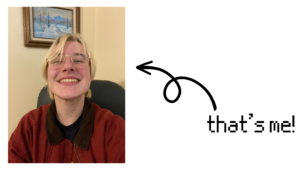 Hi, I’m Zephyr. I use he/him or they/them pronouns and this semester, I did a lot of research on what the experience of medical gender transition looked like for the average trans person in the late 80s and early 90s, mostly in the United States but a little bit in Canada as well.
Hi, I’m Zephyr. I use he/him or they/them pronouns and this semester, I did a lot of research on what the experience of medical gender transition looked like for the average trans person in the late 80s and early 90s, mostly in the United States but a little bit in Canada as well.
The title of my interactive game is “So you’re gender nonconforming in 1989. what are you going to do about that?” I picked this specific time period to concentrate my research on because the 1990s saw an explosion of trans activism and thus public perception. Hence, 1989 exemplifies the advancements of the trans community from the 60s onward.
Going into this project, I set out to answer the questions o:
- What did the process of acquiring gender affirming healthcare look like?
- In the absence of the internet, how did someone find reliable healthcare providers?
- What did someone have to pay those medical professionals?
- How did someone’s daily/weekly/monthly process of hormones compare to mine?
To answer these questions, I turned mainly to the Digital Transgender Archive. The DTA contains digitized files concerning transgender and gender non conforming people from a wide variety of collections across the country. I found photographs, letters, brochures, magazines, books, and oral histories.
I chose to mainly represent my research as a choose your own adventure interactive game. This was for two reasons: first, the way someone approached their transition was VERY very driven by what their life had looked like up until that point. Someone married with kids would have a different approach to a young adult who just moved to a city. To simulate this, I make you choose how to navigate the experiences I present. By making you choose how to experience my project, I’m hitting my second point: you’re contending with the realities of being trans in 1989. No matter how the person clicking through the game identifies, for a little bit, they’re pretending to be a trans person who is hitting the roadblocks and complications that go along with that life.
So, why did I do this project? Well, as you might be able to tell from the everything about me, I’m trans myself. I know what it’s like to seek out gender affirming healthcare now, and I wanted to find out what someone like me would have done to pursue a transition thirty years ago. That’s why I think my topic is cool. Why is it important for me to do a whole public history project on it? Well, one only has to look at the worrying and abrupt rise in transphobic laws, bills, and violence over the last few years. As trans rights are taken away, we see that life is better for trans people today. it is horrifying that anyone wants to take that away.